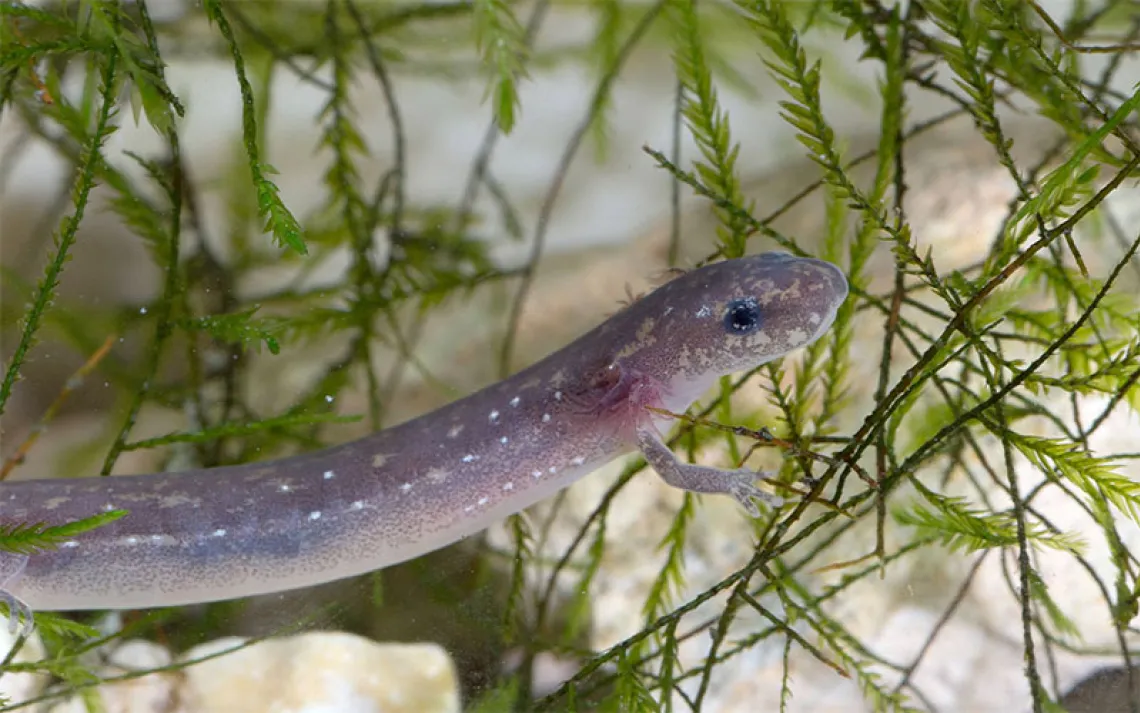Building a Better Lionfish Trap
Some see a venomous, spiny fish. Others see a business opportunity.

Pacific lionfish are destructive invaders in Atlantic waters. A grassroots campaign is now targeting them for elimination. | Photo by F1online digitale Bildagentur GmbH/Alamy
As I scan the ocean, the divers start popping up, floating in the greenish-blue waves against the backdrop of the Fort Lauderdale, Florida, skyline. They climb aboard the boat, unhook their oxygen tanks, set aside their spears, and dump the contents of their haul onto the deck—chubby fish with long, feathery fins.
The divers' catch is lionfish, infamous for their 18 venomous spines. Today's bounty ranges from foot-long to palm-size fish, but you wouldn't want to hold one. Even dead, a lionfish can deliver a sting that lasts for days.
The divers swap stories. "I speared mine as it came out of a crevasse," says one. "This one was so big, I had trouble sticking it into the ZooKeeper," says another. He points to his now-empty container, which looks like the love child of a yoga bag and the plumbing-supply section of a hardware store.
Allie ElHage climbs onto the boat last. ElHage never expected to become a lionfish hunter. But a decade ago, when he was living in Curaçao, the owner of a local coffee shop told him that he should design something to protect divers from lionfish.
"What's a lionfish?" ElHage asked. He got an earful.

Sign up to receive Sierra News & Views
Get articles like this one sent directly to your inbox weekly.
With this action you affirm you want to receive Sierra Club communications and may vote on policy designated by the Sierra Club Board.
Lionfish were first spotted off the Atlantic coast in the 1980s. It's not clear how they made it there. Maybe they traveled in a ship's ballast; maybe they were abandoned aquarium fish. What is clear is that they multiply fast and eat a tremendous number of juvenile fish while they do it. A study of a coral reef in the Bahamas found that two years after a rise in the lionfish population, the biomass of the 42 species that lionfish eat had declined by 65 percent.
Scientists aren't sure what preys on lionfish in their native Pacific—possibly sharks or eels, whose Atlantic counterparts may not have yet learned to recognize lionfish as a food source. Right now, the only predators to keep them in check are humans.
In Curaçao, some divers hunted for lionfish with birdcages. One diver would hold the cage door open while another tried to stick the fish inside—a cumbersome underwater feat that did little to protect divers from being stung. ElHage was not a diver, or even an inventor. He was an interior designer. But work was slow in the wake of the 2008–09 global recession, and he found himself in the hardware store looking for something a diver could use to hold a lionfish without getting stung. ElHage settled on a plastic tube and a flexible funnel cut in such a way that objects could go in but not easily come out.
ElHage enlisted his nephew and his friends as beta testers. "I gave them ZooKeepers when they went diving and then took them back and listened to their criticisms," he says. "I also swore them to secrecy, because I wanted to patent it." The team's suspiciously large lionfish hauls soon attracted attention, but they kept their word and refused to talk until the patent cleared.
In 2011, ElHage got scuba-certified, moved to Sarasota, and set up a ZooKeeper assembly line in his garage. It was a family operation—he assembled and shipped the lionfish containers while his wife did the books. At first, sales were slow, but word got around, especially after ElHage began to show up at lionfish tournaments, ZooKeeper in tow. He bought a boat and decorated it with a spiky, lionfish-inspired print he designed himself.
A diver can make good money hunting lionfish, says Dane Shields, a professional diver who has joined today's hunting expedition. Shields has a job cleaning ships' hulls and salvaging wrecked vessels but hunts lionfish on his days off. Local seafood distributors pay about $5 a pound for lionfish, to which the Florida Fish and Wildlife Conservation Commission adds $3 a pound as an incentive.
In a heavily infested area, a pro can catch over a dozen lionfish in a single 30-to-40-minute dive, netting 120 to 150 pounds and earning over $1,000 a day. That's not as lucrative as it seems when you count the expenses of a boat and diving equipment. But it can make a nice revenue stream for people who are diving for fun and pros who make their living by diving for other deepwater fish like gag groupers.
In some areas, the hunts seem to be making a difference. Divers report that lionfish are harder to find in reefs where recreational divers go hunting, though at depths of over 130 feet, which are off-limits to most divers, they are still abundant.
As ElHage's interior design business began to rebound, making and selling ZooKeepers grew less appealing. Last summer, ElHage sold the business to Timothy Robinson, a local dive shop owner. ElHage is excited to once again be a full-time designer, though, he says, he'll never quit diving.
The boats tie up in a canal behind Robinson's shop. ElHage opens the cooler and begins carefully cutting the spines off several fat-bellied lionfish. He cuts the fish into small chunks and adds finely diced tomato, cucumber, jalapeño, onion, mango, and cilantro, dressed with a mix of lime, orange, and mango juices. The ceviche is, to my surprise, delicious. The tender, snow-white flesh resembles cod but melts in my mouth like butter. I think back to when ElHage gutted one of the fish and a tiny grouper slid out—the last thing the lionfish ate before it became dinner itself.
This article appeared in the Winter quarterly edition with the headline "Florida's Most Wanted."
 The Magazine of The Sierra Club
The Magazine of The Sierra Club



